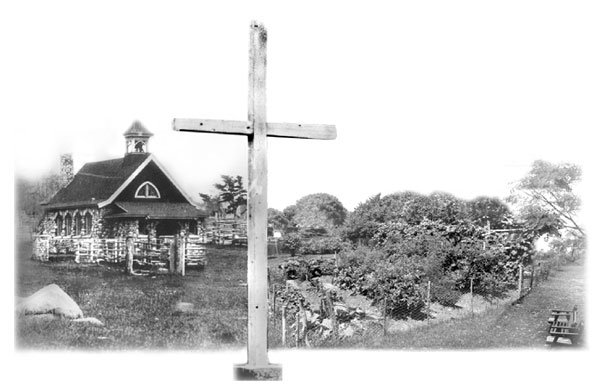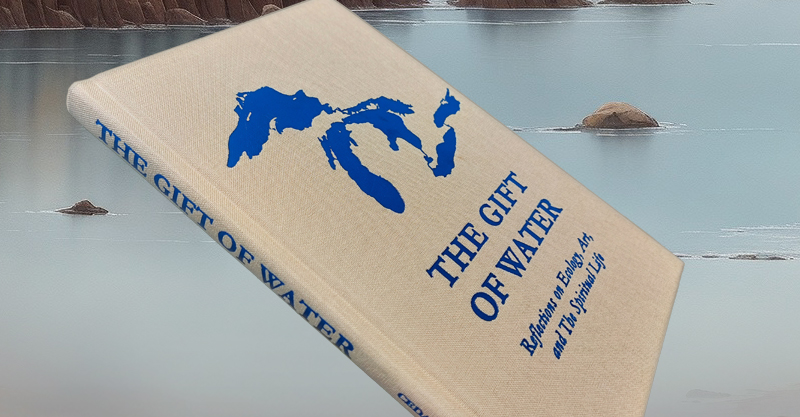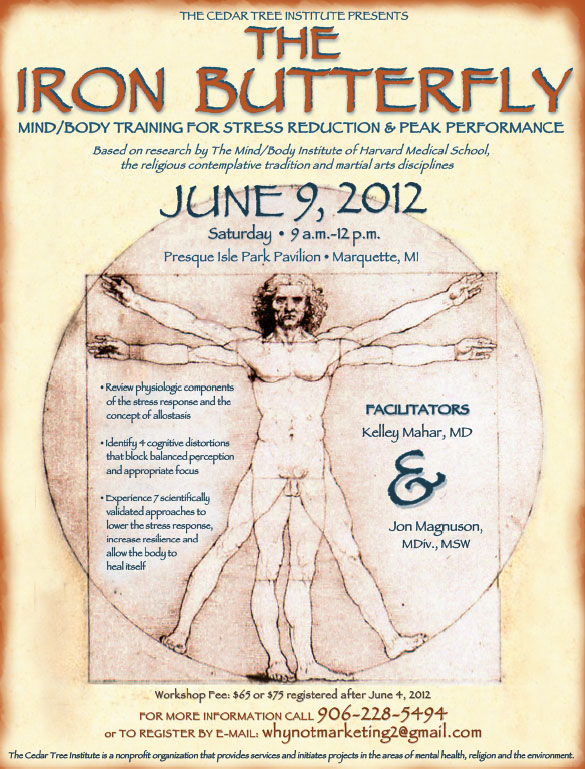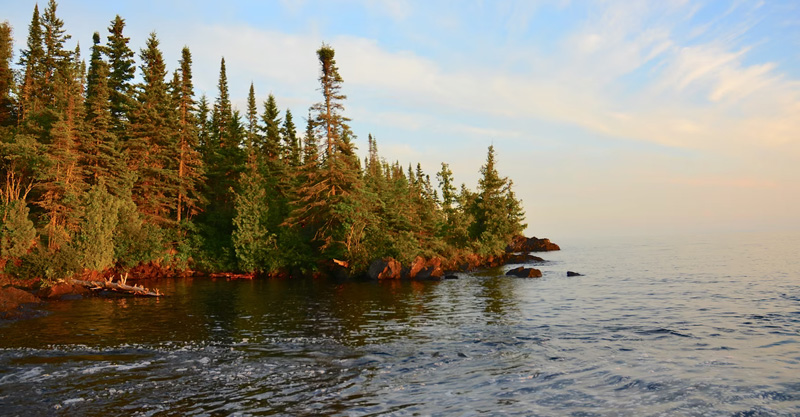from Marquette Monthly December, 2002
Reflections on the cross and sacred pipe
‘Twas in the Moon of Wintertime, when all the birds had fled…
Evening had fallen. A hard, cold wind was blowing. I arrived a few minutes early and found an empty space in a back pew of St. Peter Cathedral. It was the first week of December 2000. Having returned to Northern Michigan after a twenty-year sojourn, this was my first visit to Marquette’s annual Choral Society Christmas Concert. Over time, professional obligations and interests had taken me to numerous choir performances, many sophisticated and renowned, in Chicago, Seattle and Minneapolis. This night was to be unique.
I never will forget one particular carol sung near the close of the evening’s performance, “‘Twas in the Moon of Wintertime.” A program note stated it was composed in 1639 by the Jesuit priest, Jean de Brebeuf. It was written during de Brebeuf’s mission among indigenous peoples in what is now Canada, but then was called “New France.”
Jean de Brebeuf, a contemporary of Father Marquette, was martyred along with a small band of American Indian Christians in 1649. The account of his courage, and the compassion for his persecutors (a hostile group of Hurons) was passed down with respect among American Indian tribes into the nineteenth century. The story traveled as far west as the Oregon Territory.
The hymn’s words were set to a French folk melody, the lyrics grounded in images from long, hard winters. The haunting melody filled the sanctuary, its mystical cadence echoed footsteps from another time, of forgotten woodland trails, of a ghost-like people of the forest.
St. Peter Cathedral was illuminated magically by candles that night. Snow lay on the frozen ground outside, the sanctuary was filled to overflowing. The crowd was dressed for the weather with boots, parkas, scarves and hats of all colors and shapes. We sat close together, shoulder-to-shoulder, no pretense between any of us that night. Forty-five feet below in a stone crypt lay the bones of the Snowshoe Priest Frederic Baraga, who died worn and exhausted from a lifetime of work as a priest and Bishop in Northern Michigan. Baraga was an unusual spiritual leader, modest, generous it appears to a fault, and not always appreciated for his solidarity with Native American peoples of this region. Among his legacy is an English-Ojibway dictionary, regarded still as a document of exquisite research and useful reference.
Historical records tell us Jean de Brebeuf, the composer of that evening’s carol, took vows among the Jesuits, more formally known as the Society of Jesus, in the early seventeenth century. Founded a century earlier by Ignatious of Loyola, the order has produced some of the finest scholars of the Church of Rome. Forbidden to hold any high office in the church, Jesuits consistently have served as the most active and adventuresome missionaries. True to their discipline and unpredictable spirit, they have in our own time been at the forefront of fostering ecumenical dialogues and new partnerships with other religious traditions. Between 1611 and 1764, more than 300 Jesuits, known as “Black Robes,” came from France to North America to establish what came to be called the “Forest-Roaming Church.”
Although the work of Jesuits among American Native peoples is idealized and romanticized by many followers of Catholicism, most historians, both within and outside the church, see their record as a more complex mix of cross-cultural conflict, ethnocentrism and self-serving zeal. Along with their extraordinary map-making and scientific observations, in numerous instances they showed respect for indigenous peoples and spiritual beliefs that seems remarkable even by today’s standards. Their visionary work led them to live and travel among North American tribes that included Hurons, Montanais, Ottawas, Illinois, Sioux and the Ojibway of Northern Michigan.
The legacy of Christian missionaries among American Indians, in the Upper Peninsula as across North America, is a complex story of cultural conflict, exploitation, collaboration and creative adaptation. On one hand, it reflects the shadowy side of a church’s history in a new land. Heavy-handed policies often were imposed and supported by government sanctions. Suppression of traditional Native practices and beliefs was the norm, and arrogance of Anglo ethnic supremacy reigned. On the other hand, there were exceptions, some of them of great significance.
Ironically, the single most important legal precedent for Native American legal rights today is based on an early Supreme Court ruling referred to as Worcester vs. the State of Georgia (1832). It’s a case filed by a missionary on behalf of the Cherokee Nation to defend American Indian Nations in their struggle to protect tribal self-government. Although President Andrew Jackson refused to abide by the decision, Supreme Court Justice John Marshall’s ruling continues as the key legal reference in major court cases involving Native treaty rights, fishing and hunting regulations, state gaming agreements and disputes over taxation on Indian lands.
O children of the forest free
Contemporary and diverse voices speak to us from this troubled legacy of cross and sacred pipe.
April Lindala, a descendant of the Six Nations (a Native American confederation of tribes originally from the Eastern Seaboard) currently serves as NMU’s Assistant Director of Diversity Student Services and adviser to the Native American Student Association.
“There are 172 self-identified Native Americans here at the university,” she said over lunch at a local cafe. Her life has led her along culturally diverse paths. Having grown up in varied Christian churches, she now practices prayers and rituals from the Anishinabe Native tradition. I remember her atop a wooded ravine near Lost Creek in Powell Township a couple of summers ago. We were working with good friend Chuch Magee on a tree planting project. A number of volunteers from tribes and young people from the juvenile court system were about to spend the morning working to restore a piece of heavily logged public land. Before we began, I invited her to pray for the work. She sang a traditional blessing song. It echoed with stunning, beautiful clarity up and over the tree line.
We continued our conversation about an event the previous night. The university’s Ethnic and Cultural Diversity Committee and School of Nursing hosted a Navaho traditional midwife for a conference on cross-cultural medicine. I’d joined the group for a standing-room-only presentation at the University Center. Ursula Knoki-Wilson began her presentation reflecting on her afternoon with NMU’s Native students. She said she’d spent the time sharing stories about teachings from the sacred mountains near her home in Arizona. She remarked that she had appreciated especially “listening to the water stories of the Ojibway.” I’ve hosted many guests to Marquette over recent years, but rarely have we talked of water stories. Certainly never in any sacred way. The dominant culture and religious tradition of which I am a part has few such spiritual connections to the earth. We are the poorer for it.
Martin Reinhardt, a member of the Sault Band of Chippewa Indians, sat back in his chair behind a desk in his office on a late summer day. We were engaged in conversation about his new role as Director of Native American Studies at NMU. After I introduced myself, he commented with a refreshing, honest response: “I’m wary of clergy and churches.”
“I can understand that,” I said.
Our conversation unfolded for the next hour or two with recollections of mutual acquaintances, doses of good humor and reflections on our respective families. He had just returned from a field trip with his wife as part of an NMU class on medicinal plants.
“It’s a great course,” he said. “We can all learn from one another.” He told me the Native American Studies Program currently has twenty-five courses offered on such diverse subjects as Ojibwe language, law and Indian education, and cultural history. Two full-time faculty and three part-time adjunct instructors make up his teaching staff. We talked about the mutual “usefulness” that missionaries and Native communities recognize in their sometimes uneasy interactions and allegiances.
“Identifying with certain religious groups during the Treaty signing had certain benefits…for both sides,” he said.
Wilma Chaillier, a Lakota Sioux originally from the Rosebud Reservation in South Dakota, warmly welcomed me upon my arrival at Marquette’s Indian Center. She was volunteering this afternoon as a receptionist and was patiently working on some bead work. We were inside the American Indian Coordinating Council’s Center (AICC) on Washington Street, just west of Marquette’s Harlow Park. We shared some mutual experiences we’ve had on the Rosebud Reservation. I once was involved with some projects at the St. Francis Mission there, not far from where she grew up. She moved here, she said, years ago when her husband was working at K.I. Sawyer Air Force base.
Moments later, Julie Snyder, a community representative on the Coordinating Committee Board arrived for a scheduled conversation. She cordially offered me some coffee and led me to a neatly ordered meeting room. Arranged along the walls of the Center were several bookshelves of publications and brochures, collections of Native crafts, T-shirts, jewelry, and a collection of posters with phrases like, “Proud to Be Indian,” “Official Indian Car” and “America, Love It or Give It Back.”
I asked her about the Native population in Marquette County
“There were 943 Indian people in the county’s 1990 census,” she said. “But there’s probably a greater number now that more low-cost housing is available.”
She went on to describe the Coordinating Council’s goals and vision.
“We’re a coordinating agency, ten years old, representing different Native groups and providers of services to indigenous peoples in our area. We’re intertribal. But most of us are of Ojibway lineage.”
Five of Michigan’s seven American Indian Reservations are located within the boundaries of the Upper Peninsula. Many Native people live in communities off reservation, choosing a more assimilated lifestyle. The AICC represents a number of diverse tribal backgrounds and cultures. We talk about the sensitive subject of the encounter between traditional Native and Christian religious practices.
“There’s been a lot of hurt,” she said. “There’s a ritual used by some traditional people to open the heart, the intuitive side of persons. It involved symbolically removing the sign of the cross off the forehead. Traditional practices like these have tried to bring back a balance to the spiritual world.”
Before their light the stars grew dim, and wondering hunters heard their hymn…
Each December, in remembrance of that night in the cathedral, I often hum to myself the melody of de Brebeuf’s 400-year-old carol. The contrast between a barren, cold landscape and the carol’s promise of spiritual renewal is dramatic in tone and lyric.
This time of year many of the world’s spiritual traditions lift up hope and promise for some vision of healing.
We need such renewal as never before.
Last month in Duluth the Lake Superior Binational Forum, a citizen advisory group on which I serve, learned that Zebra mussels, an exotic species first introduced by ballast water from international ships to the Great Lakes in 1986, have caused an even more devastating impact on our environment than was first thought. Zebra mussels are called “filter feeders.” They literally filter water from lakes and lagoons making them crystal clear.
To casual observers, that’s good news. But along with pollutants, they also remove all natural nutrients, producing “dead” bodies of clear water. These mussels also are repositories of poisons lethal enough to be regarded officially as toxic waste. Researchers have now confirmed that as ducks eat these mussels they are dying in devastating numbers. In certain feeding areas of the Great Lakes basin, it’s been confirmed that as much as a third of our migratory flocks have been impacted.
More significant is the rising concern over mercury contamination. This substance exists naturally as a trace mineral, but since it has been used increasingly in industry and consumer goods, we’ve discovered its damaging effects on the human brain. It has a half-life, chemists tell us, of 100 to 500 years. It does not disappear.
When mercury (found in residue released by industrial processes) is absorbed in the fat of fish, it’s transformed into a lethal substance called mythelmercury. Michigan’s Department of Natural Resources releases a fish advisory warning each year.
The health risk is irrefutable. Both the DNR and the Department of Environmental Quality recommend that no pregnant woman or young child should eat any lake trout from Lake Superior.
There’s increasing evidence that we are on a collision course, out of balance with our economy, our health and the earth. In the recently published Breaking Open the Head by Daniel Pinchbeck, the author quotes Walter Benjamin, a German cultural critic, who sees our present capitalistic world as “a gigantic spiritual zombie.”
Part of any recovery of healthy religious sensibilities will involve reshaping our relationship with the earth. Appreciation and respect for diversity of beliefs and an openness to spiritual teachings that we’ve previously ignored will be part of the renewal. There’s much treasure waiting there.
A Jewish saying from the Kabbal-istic tradition tells us that God created the world and splintered his light into thousands of sparks because it was so bright. “Tikkum Olam” is a Hebrew term that describes the spiritual commitment to collecting that light and bringing healing to the earth.
Our community’s new Unitarian pastor recently told me how some years ago in North Dakota she discovered writings by Matthew Fox, a Roman Catholic theologian.
It was for her an epiphany about what he called “The Original Blessing.” For her, this meant a new appreciation and commitment to living a life in balance with the natural world. Both her experience and the Jewish call for “repairing the Earth” echo traditional Native American insights.
Just south of Montreal there’s a Mohawk Indian Reserve called Kahnawake. It’s near where Jean de Brebeuf received orders to the New World as a Jesuit.
I knelt one afternoon, a couple of summers ago, next to a small wooden altar at the mission of St. Xavier. The tomb of Kateri Tekakwitha, a Mohawk spiritual leader respected by both traditional Indian and Christian converts is located there. She died in 1679, not long after the death of de Brebeuf. As I left the chapel, I saw a parish bulletin lying open. Its closing words still haunt me.
“This Third Millennium (our new century) will be a spiritual one. Or it will not be at all.”
– Jon Magnuson
December 2002






